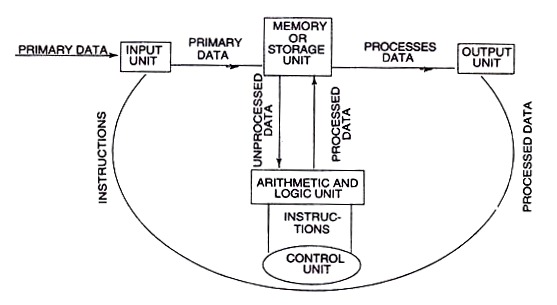The following points highlight the five main components of a computer. The components are: 1. Input Unit 2. Memory or Storage Unit 3. Arithmetic and Logic Unit 4. Output Unit 5. Control Unit.
Component # 1. Input Unit:
This unit transfers the information from outside to the memory or storage unit by any of the following methods:
ADVERTISEMENTS:
(i) Punched cards which are passed through a punched card reader;
(ii) Punched paper tape, which is passed through a punched card reader;
(iii) Magnetic tape or disc which is passed through a magnetic tape or disc reader. A magnetic tape works like a domestic tape recorder. There are two reels and a mechanism for reading and writing data. Like domestic tape recorder, data recorded on the tape may be retained permanently or may be erased by recording other data over it. The tape is usually ½ in width and of varying length and is made of plastic material.
Magnetic tapes work faster than punched cards and, like the punched cards, are used not only as an input device but also are used for storage and for recording output. Corrections can also be easily made on magnetic tape. Another additional advantage is that additional data can be inserted in this input unit which is not possible in punched paper tape or punched card after the tape or card has been punched.
Component # 2. Memory or Storage Unit:
ADVERTISEMENTS:
A series of figures are stored in this unit and are released at electronic speed for calculations. This unit retains temporarily results of sub-calculations till further processing. This unit also serves the purpose of a store for final results of calculations before passing them to the output unit.
The cost of a computer and the size of the problem which it can handle depend upon its internal storage capacity. The term buffer is also used for a storage area in a computer which temporarily holds data after input or for output.
Component # 3. Arithmetic and Logic Unit:
Required calculations and logical operations are done in this unit by taking the necessary information from the memory unit. The arithmetic unit has the ability of performing all the ordinary operations of addition, subtraction, multiplication and division at a very high speed.
The logic unit is used to make decisions where the instructions given to the computer require a decision to be made. Such a decision is of ‘yes’ or ‘no’ type.
Component # 4. Output Unit:
ADVERTISEMENTS:
This unit turns out the end product, i.e., result, report or the final information to be obtained from the computer, e.g., economic order quantity of inventory, variances etc. This unit transfers the final information to an outside document like printed paper, punched card or magnetic tape.
Component # 5. Control Unit:
This unit is also called programme controller and is the most complex unit. It is the nerve centre because each unit of the computer works under the supervision of this unit.
Once the figures are fed into the input unit, the control unit takes complete charge and handles the figures as instructed by the computer programme. Physically the main component of the computer is the Central Processing Unit (C.P.U.). It is also known as Central Computer.
This central processing unit contains the following units:
ADVERTISEMENTS:
(i) Control Unit.
(ii) Memory or Storage Unit.
(iii) Arithmetic and Logic Unit.
Hardware and Software:
ADVERTISEMENTS:
The Physical Computer System, i.e., the computer itself, as a machine, key board, mouse, printer, and related equipment used in an electronic data processing system are called hardware. All the other materials utilized in selecting, installing and operating the electronic data processing system (except the operating personnel) are known as software.
Software includes not only the computer programmes (the sequence of instructions given to the computer) but everything about the Electronic Data Processing System which helps the Computer machine and its equipment’s to perform their functions. Software is an integral part of hardware; one cannot function without the other.
